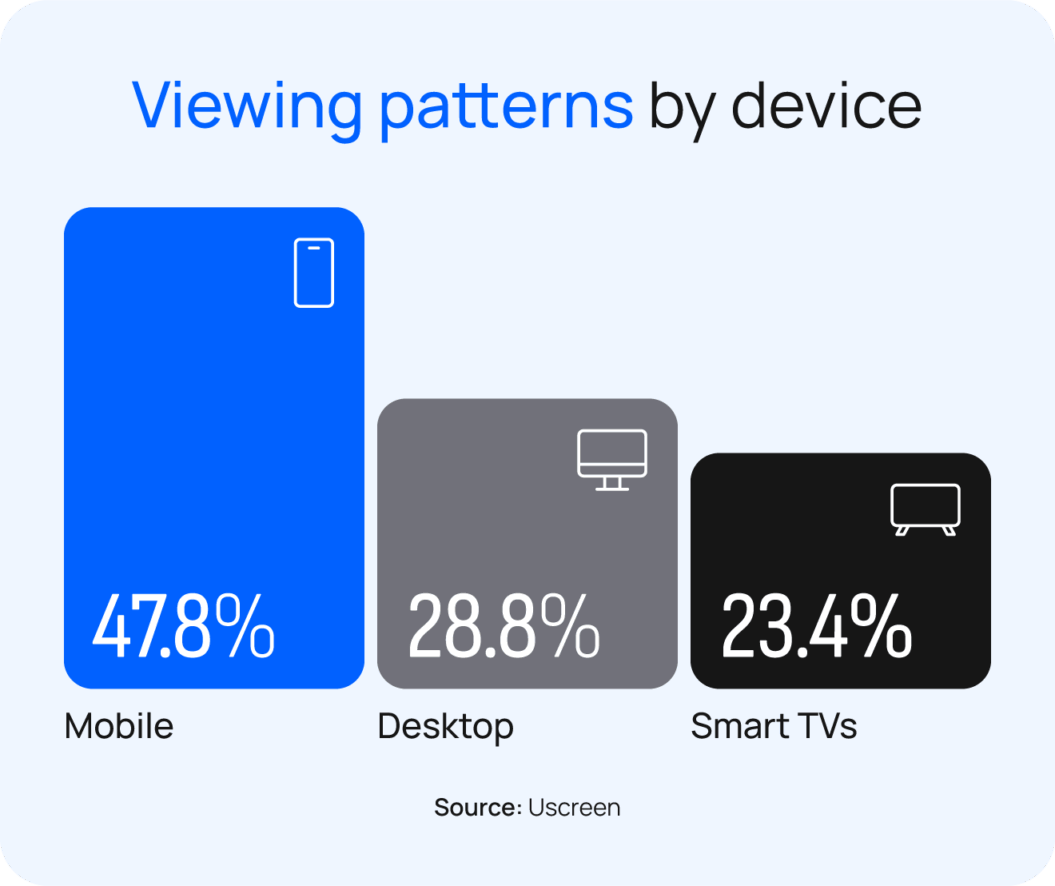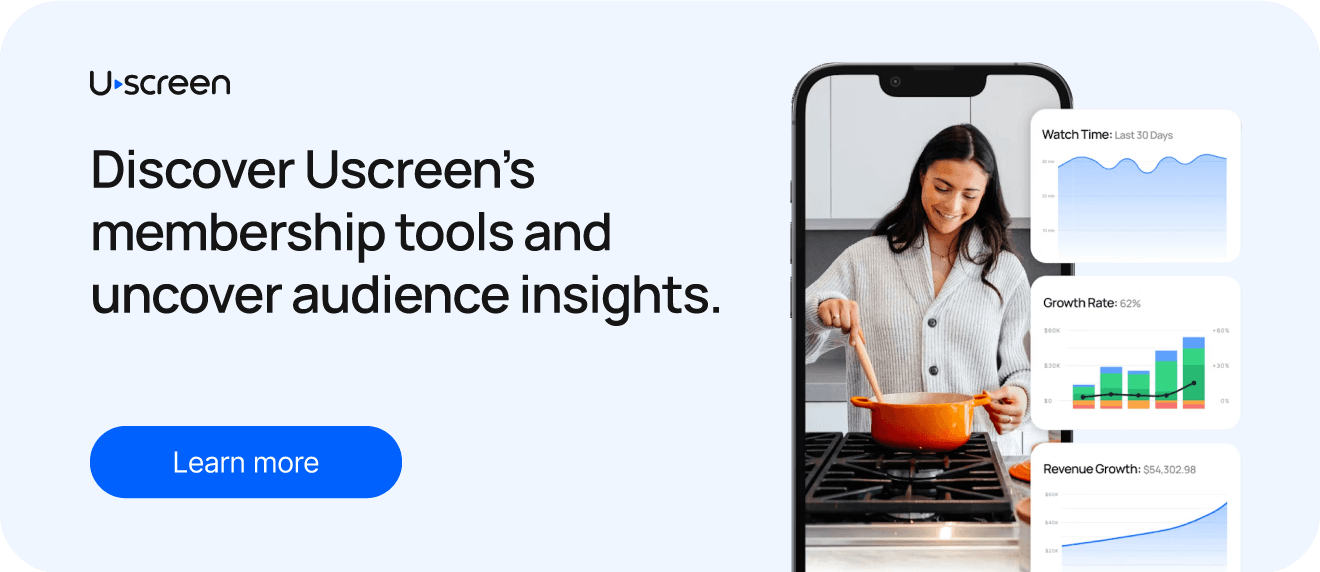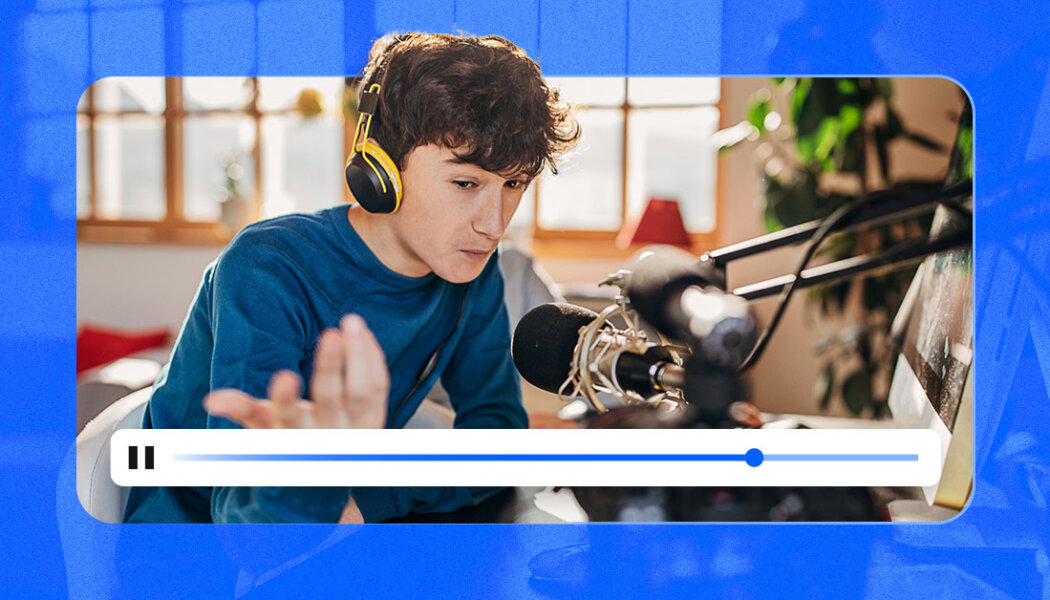The creator economy is moving fast, and simply uploading videos is no longer enough. With shifting algorithms, new platforms, and more competition than ever, creators need to think bigger than just posting content.
According to recent Uscreen data, the top 10% of earners are now generating $14 million each month, adding up to $171 million over the past year. These creator economy statistics show just how quickly creator-led businesses are scaling and how much opportunity exists for those who build strategically.
In this post, we’ll break down the video creator trends that matter most in 2025. From community-driven memberships to AI-powered workflows, you’ll get practical ways to act on these shifts. With insights from Rob Balasabas, head of partnerships and community at Uscreen, you’ll see how today’s top creators are turning audiences into businesses, building stronger connections, and securing long-term revenue.
Ready to future-proof your creator business? Let’s get started.
1. Community-driven experiences are king
In 2025, the most successful creators are shifting from being content producers to community builders. Audiences don’t just want to watch videos; they want to feel connected, seen, and part of something bigger.
Platforms like Uscreen make it possible to bring everything under one roof: exclusive content, direct access to the creator, and spaces where fans can connect.
As Balasabas explains, Uscreen helps deliver an all-in-one experience where fans can “come for the content and stay for the community” with like-minded people and access to the creators themselves.

According to Uscreen data, engaging with your community has a direct impact on retention. Users who create posts are 63% more likely to stay active than users who don’t engage with the community.
Creator story: Find What Feels Good, a global yoga community built on Uscreen, has grown beyond simple video classes into a thriving hub where members interact daily, attend live sessions, and support one another on their wellness journeys. This kind of engagement doesn’t just boost retention, it transforms one-time viewers into lifelong members.
Interactive content plays a big role in this shift. When creators use polls, Q&As, or comment threads to shape new videos, their community becomes a real-time focus group.
By offering exclusive spaces, such as members-only forums, Discord servers, or private groups, creators give fans a sense of belonging that free platforms just can’t match.
Read our guide on online community tips to learn how to create deeper connections with your audience.
Why it matters: Community features foster a deeper connection and loyalty, making the audience feel like they’re part of a movement rather than just passive viewers.
2. Resurgence of live streaming as a growth and revenue driver
Live streaming trends in video marketing have moved beyond being just for big events, becoming one of the most powerful tools for both audience growth and paid content.
Uscreen data shows how impactful this creator economy trend can be: Creators average 179.2 total views per stream (including anonymous viewers), with a single-stream peak of 20,502 logged-in users. Even more telling is that live sessions hold attention, with an average watch time of nearly 47 minutes.

As Balasabas explains: “There’s a lot of live streaming that is being leveraged by our creators, on their free platform, YouTube, and social, to drive new viewership to get discovered, but then also use those live streams as a way to promote their memberships, paid content, and paid products.”
This two-step strategy makes live streaming a key part of video marketing trends:
- Discovery on free platforms: Starting live streams on YouTube, Facebook, or Instagram brings in new viewers and sparks awareness.
- Gated content on paid platforms: Once inside a membership, creators use live Q&As and behind-the-scenes interviews to deliver value and build loyalty.
Balasabas adds that creators are maximizing the effort they put into live sessions:
They are leveraging live streams to continue that engagement [with] Q&As, live workouts, live sessions, live interviews inside of their membership first, so that paying members can interact with them and their audience. Then from there, they repurpose and distribute the content to their podcast, YouTube, and Instagram. But essentially, they’re trying to get more juice out of the orange.
Why it matters: Live streaming offers both reach and retention. By combining free discovery streams with exclusive paid experiences, creators capture attention, deepen relationships, and generate recurring revenue.
3. Diversified monetization beyond platform revenue
One of the biggest content creation trends of 2025 is the shift away from relying solely on platform ad revenue. “Most creators who are really successful have multiple revenue streams,” says Balasabas. For many, this means exploring YouTube monetization alternatives and building models that give them more stability and control.
These multiple reliable income streams help creators stabilize their businesses and unlock long-term growth. Instead of depending solely on ads, they’re learning how to monetize videos without ads through strategies like memberships, digital products, and shoppable content. Here are some of the revenue streams creators are turning to this year:
Direct-to-audience memberships
Hosting gated content on their own platforms allows creators to own both their audience and their payments. Platforms like Uscreen make it possible to monetize content, turning loyal fans into paying members.
Balasabas says that a lot of creators “have their membership [platform] on Uscreen where they own the content and they own the audience, meaning they have access to the audience through their emails.”
Brand deals and sponsorships
Collaborations with brands that align with a creator’s values remain a core revenue stream. As Balasabas notes, “They tend to have brand deals and sponsorships” alongside other monetization paths.
Live events
From pop-up workouts in Central Park to full-scale summits, creators are leaning into both in-person and virtual events to connect with fans and increase revenue.
Merch
Merch remains a popular revenue stream. Balasabas points out that because memberships build loyal audiences, “that following wants to look like them, and so merch is a really easy [passive] revenue stream.”
Digital products
Guides, templates, and downloadable resources give creators a scalable way to sell their expertise. Digital products are also highly profitable because they require little overhead once created.
Licensing deals
Some creators now partner with OTT platforms like Prime, Tubi, or Pluto, licensing their content much like a traditional media company would.
Exclusive content
Exclusive drops, such as early access videos, behind-the-scenes extras, or members-only series, reward paying fans while building FOMO among free viewers.
Shoppable videos
Social commerce is on the rise. Shoppable videos integrate products directly into content, giving fans the chance to buy in real time while supporting the creator.
Why it matters: Diversification reduces risk and builds sustainability. By moving beyond volatile ad revenue, creators gain more control, foster loyal communities, and grow like true media companies.
4. Tiered gated content
Creators are moving away from the all-or-nothing membership model and leaning into tiered gated content. By offering different levels of access, creators can meet their audience where they are, whether that’s a casual fan looking for on-demand videos or a highly engaged supporter who wants exclusive perks.
According to Uscreen data, free trial conversion rates for subscription-based creators are around 57%, showing just how effective flexible offerings can be.
As Balasabas explains:
[Uscreen sees a lot of] trends in gated tiered memberships. [Creators] don’t want to just have one offering — they realize that different members are more bought in than others, or have maybe different levels of support like bronze, silver, gold.
Then it’s about tiering access to the on-demand content versus the live stream sessions, or maybe having some exclusive channels in the community, like early access to new content or merch or tickets to their live events.
This approach not only makes memberships more accessible but also increases sustainability for creators. A basic tier might offer on-demand content, while higher tiers unlock features like:
- Live stream access
- Exclusive community channels
- Early access to merch or tickets
On top of that, offering localized, multi-currency options can boost revenue by 15% or more, helping creators serve international audiences more effectively. Community engagement strategies are a key piece of this puzzle, making memberships feel personal and rewarding at every level.
Why it matters: Tiered gated content balances accessibility with premium value. It gives fans options that fit their budget and level of commitment while ensuring creators are fairly compensated for the time, effort, and resources they put into their work.
5. AI moves from tool to teammate
One of the biggest AI content creation trends in 2025 is the shift from viewing AI as a competitor to treating it like a creative teammate. Instead of replacing creators, AI is becoming an assistant that helps streamline workflows, spark new ideas, and enhance content strategies without diluting authenticity.
As Balasabas explains, “[AI is helpful for] coming up with different ideas for content topics, going through your comments on YouTube and identifying and filtering through those comments to see what topics are hitting really well for your audience.”
Many Uscreen creators are already embracing AI this way, using it to brainstorm content ideas, repurpose long-form videos into short clips, and even shape email sequences to nurture members.
When it comes to AI, Uscreen aims to help creators not use the AI to just create the content for them, but to use it as an assistant or an employee to bounce ideas back and forth. Rather than just making a video script, it’s about brainstorming together
Pro tip: Treat AI like a creative partner, not a replacement. Use it to spark ideas, speed up editing, or repurpose content — but always layer in your unique voice to keep your content authentic.
6. Short form goes premium for quick wins, but long form drives deeper engagement
Short-form video is no longer just about quick likes. It’s becoming a direct path to revenue. Platforms like YouTube Shorts, TikTok, and Instagram Reels are experimenting with subscription-based short-form features, giving creators the ability to share exclusive clips with paying members. For many, learning how to monetize YouTube Shorts is the first step to turning viral reach into recurring income.
Posting short, snackable content helps creators grow reach and spark interest, while gated clips offer a clear path to monetization. But here’s the twist: While short form drives quick wins, long form is where members stick around. Uscreen data shows that paying members spend more time with longer videos, often watching on larger screens. The percentage of views on different platforms confirm this:
- Mobile: 47.8%
- Desktop: 28.8%
- Smart TVs: 23.4%
Short clips may be the hook, but longer content builds the community that keeps subscriptions alive.

Why it matters: Short form is your discovery engine, but long form is your retention engine. Quick clips get people in the door, but it’s the deeper, binge-worthy content that convinces them to stick around and pay month after month.
7. Global-first audience growth through localization and timing strategies
Creators aren’t just thinking local anymore; they’re building global audiences from day one. By adding multilingual captions, localized subtitles, and subtle cultural nuances, they’re making content feel personal, regardless of where fans are watching.
Release times are also shifting, with more creators publishing around international peaks instead of adhering to local schedules.
And it’s working. Over the past year, 60% of creator revenue growth on Uscreen has come from international subscribers.
Creators do really care about the data…they are paying attention to which countries their viewers are tuning in from.
That data-driven mindset is shaping decisions like whether to add closed captions, enable multi-currency payments, or run engagement campaigns (emails, reminders, and live stream invites) tailored to global audiences. The key isn’t just having numbers, it’s knowing what to do with them
Our data analyst will actually sit down with our creators to translate that data so that they can understand what they’re looking at, and they can use that data to apply it to their business.
Uscreen makes it easier to connect the dots. Data analysts work directly with creators to unpack audience insights, spot untapped markets, and identify strategies to re-engage viewers who may be slipping away.

Third-party research echoes this trend. According to YouTube’s 2025 Trend Report, the platform now operates in more than 100 countries and 80 languages, fueling global media diversity and enabling creators to grow audiences far beyond their local markets.
Uscreen data backs it up, too: Over the last 12 months, 70% of watch time came from the Americas, 22% from Europe, and the rest from other continents. While these proportions have remained stable, international subscriber growth is driving real revenue impact.
Why it matters: Going global expands revenue potential, increases brand deals, and builds a more resilient audience base when one market slows.
8. UGC for brands becomes mainstream
User-generated content (UGC) has gone from a nice-to-have to one of the core content creator trends. It’s not just mega influencers with millions of followers driving this trend.
More and more brands are hiring everyday creators to make authentic, high-quality videos for ads, product launches, and social campaigns. And they’re paying well for it, without asking creators to post on their own channels.
For creators, this opens up a new revenue stream. Instead of fighting algorithms or chasing subscribers, you can focus on what you do best: making content that feels real and relatable. According to our latest video trends post, 90% of businesses say UGC is more authentic than traditional branded content. That authenticity is exactly what audiences respond to.
Why it matters: UGC creation offers steady income and portfolio growth without the algorithm pressure of growing a massive personal audience.
9. Niche-first strategies to build loyal, high-converting audiences
Instead of chasing the next viral trend, today’s top creators are going niche — and it’s paying off. Choosing a content niche, whether it’s vintage camera repair, minimalist cooking, or indie game reviews, helps creators attract highly engaged audiences who convert more easily into paying members.
With Uscreen, we’ve seen it firsthand with communities like Your Book of Memories, which serves scrapbook enthusiasts, Jump Rope Dudes, who’ve built a global fitness following around skipping ropes, and Home Rave, which streams live DJ sets for electronic music fans.
These audiences may be smaller than mainstream ones, but they’re loyal, engaged, and far less impacted by platform algorithm shifts.
According to Uscreen data, the number of Media & Entertainment stores created on the platform has more than doubled in the last 12 months, as has Faith & Spirituality.

But the strongest performers continue to be Fitness and Yoga & Wellness memberships, where the in-person gym model translates naturally to online subscriptions. As Balasabas explains:
Fitness and wellness continue to be really strong for us. That model translates really well online, since people are already used to the in-person gym membership model. We’re also seeing a lot of studios that figured out their in-person business after the pandemic now launching online memberships to expand their markets. Beyond that, we’re seeing growth in mainstream creators (comedy, lifestyle, personal development) who used to focus on one-time courses but are now shifting to memberships. They’re looking for recurring revenue and a way to serve their audience through an ongoing community.
That shift toward memberships shows why niches are so powerful. When you focus on a specific audience, you create a space that feels like home. That sense of belonging keeps people coming back and makes memberships sustainable.
Why it matters: Niching down doesn’t just grow an audience, it grows the right audience. Loyal fans are easier to convert, more likely to stick around, and more valuable to your business over time.
10. Hybrid creator-educator roles that turn expertise into revenue
Entertainment alone won’t cut it anymore. The most successful creators are packaging their expertise into the best online course platforms, workshops, consulting sessions, and eBooks alongside their regular video content.
Instead of relying only on ad revenue or tips, they’re turning their knowledge into scalable products that sell on repeat. Many are exploring how to sell online courses as a way to monetize their expertise and expand beyond traditional content.
With Uscreen, creators can seamlessly bundle their videos with paid courses and memberships. That means you don’t just post content, you build a business that monetizes your expertise and keeps fans coming back for more.
Why it matters: Education-based offers provide stable income, deepen authority in your niche, and give fans more ways to engage beyond watching videos.
Looking ahead: The future is about owning your IP
The future of the creator economy comes down to one word: ownership. Creators are no longer just renting space on social platforms or promoting someone else’s products. They’re building their own intellectual property (IP), like products, services, and memberships, that turn their brand into a business.
Owning your IP means owning your audience relationship, your revenue, and your long-term growth. It’s the difference between being at the mercy of an algorithm and running a company on your own terms.
Why it matters: When you control your IP, you build stability and independence. You’re not just a content creator anymore; you’re a business owner with a brand that can scale.
Don’t just watch trends — own them
The biggest opportunity in 2025 is acting on video creator trends before everyone else does. Trends aren’t just noise; they’re signals showing you where the audience is moving and where video monetization opportunities are growing. If you move first, you win.
Here’s your checklist to stay ahead in the upcoming year:
- Create community-driven experiences.
- Diversify your monetization strategy.
- Use tiered gated content.
- Leverage AI as your brainstorming and editing partner.
- Target niche and global audiences to create loyal fans.
Ready to own your audience and your revenue? Start your free trial with Uscreen today.
FAQ
What kind of video content is popular?
Short-form video, live streaming, and educational content are some of the most popular formats right now. Audiences want quick entertainment, behind-the-scenes access, and tutorials they can act on immediately. Creators who mix storytelling with authenticity tend to see the strongest engagement.
In what ways will social media platform updates influence creator strategies?
Platform updates can shift how content is discovered, monetized, and recommended. Creators will need to adapt quickly, whether that means leaning into new algorithm preferences, experimenting with fresh formats, or using new monetization features to diversify income. Staying flexible is key.
How will the rise of live streaming and user-generated content impact creator success?
Live streaming and UGC make audiences feel more connected to creators, boosting trust and loyalty. As more platforms push these formats, creators who embrace them can grow stronger communities and open up new revenue streams like real-time donations, memberships, and sponsored collaborations.
Is YouTube losing or gaining popularity?
YouTube is still gaining popularity, especially with long-form and educational content. But many creators are also turning to platforms like Uscreen to build owned audiences and monetize directly.







